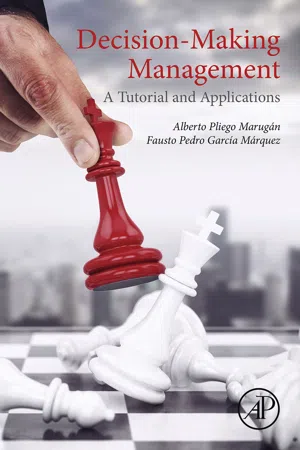
Decision-Making Management
A Tutorial and Applications
- 148 pages
- English
- ePUB (mobile friendly)
- Available on iOS & Android
Decision-Making Management
A Tutorial and Applications
About this book
Decision-Making Management: A Tutorial and Applications provides practical guidance for researchers seeking to optimizing business-critical decisions employing Logical Decision Trees thus saving time and money. The book focuses on decision-making and resource allocation across and between the manufacturing, product design and logistical functions. It demonstrates key results for each sector with diverse real-world case studies drawn primarily from EU projects. Theory is accompanied by relevant analysis techniques, with a progressional approach building from simple theory to complex and dynamic decisions with multiple data points, including big data and lot of data. Binary Decision Diagrams are presented as the operating approach for evaluating large Logical Decision Trees, helping readers identify Boolean equations for quantitative analysis of multifaceted problem sets. Computational techniques, dynamic analysis, probabilistic methods, and mathematical optimization techniques are expertly blended to support analysis of multi-criteria decision-making problems with defined constraints and requirements. The final objective is to optimize dynamic decisions with original approaches employing useful tools, including Big Data analysis. Extensive annexes provide useful supplementary information for readers to follow methods contained in the book.- Explores the use of logical decision trees to solve business problems- Uses mathematical optimization techniques to resolve 'big data' or other multi-criteria problems- Provides annexes showcasing application in manufacturing, product design and logistics- Shows case examples in telecommunications, renewable energy and aerospace- Supplies introduction by Benjamin Lev, Editor-in-Chief of Omega, the highest-ranked journal in management science (JCR)
Frequently asked questions
- Essential is ideal for learners and professionals who enjoy exploring a wide range of subjects. Access the Essential Library with 800,000+ trusted titles and best-sellers across business, personal growth, and the humanities. Includes unlimited reading time and Standard Read Aloud voice.
- Complete: Perfect for advanced learners and researchers needing full, unrestricted access. Unlock 1.4M+ books across hundreds of subjects, including academic and specialized titles. The Complete Plan also includes advanced features like Premium Read Aloud and Research Assistant.
Please note we cannot support devices running on iOS 13 and Android 7 or earlier. Learn more about using the app.
Information
Introduction
Abstract
Keywords
1.1 Background
1.2 Introduction to the Decision Making
Table of contents
- Cover image
- Title page
- Table of Contents
- Copyright
- List of Figures
- List of Tables
- Authors
- Foreword
- Preface
- Nomenclature
- Summary
- Chapter 1: Introduction
- Chapter 2: Logical Decision Tree Analysis
- Chapter 3: Binary Decision Diagrams
- Chapter 4: Case Studies
- Chapter 5: Dynamic Analysis of LDT
- Chapter 6: DM Optimization
- Annex A: Boolean Algebra
- Annex B: Symbology of the Logical Decision Tree
- Annex C: Probability Theory
- Annex D: Importance Analysis: Practical Cases
- References
- Index